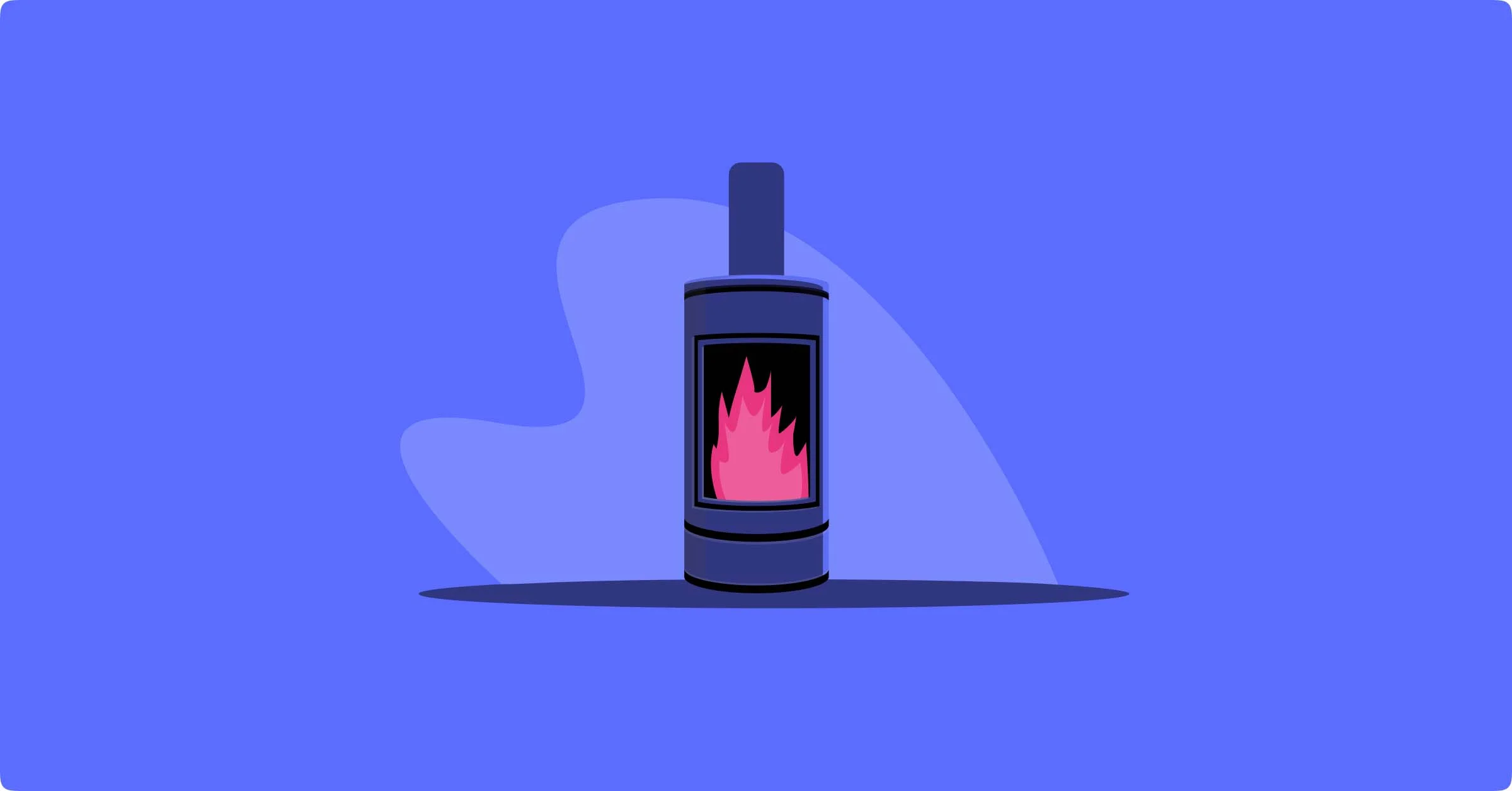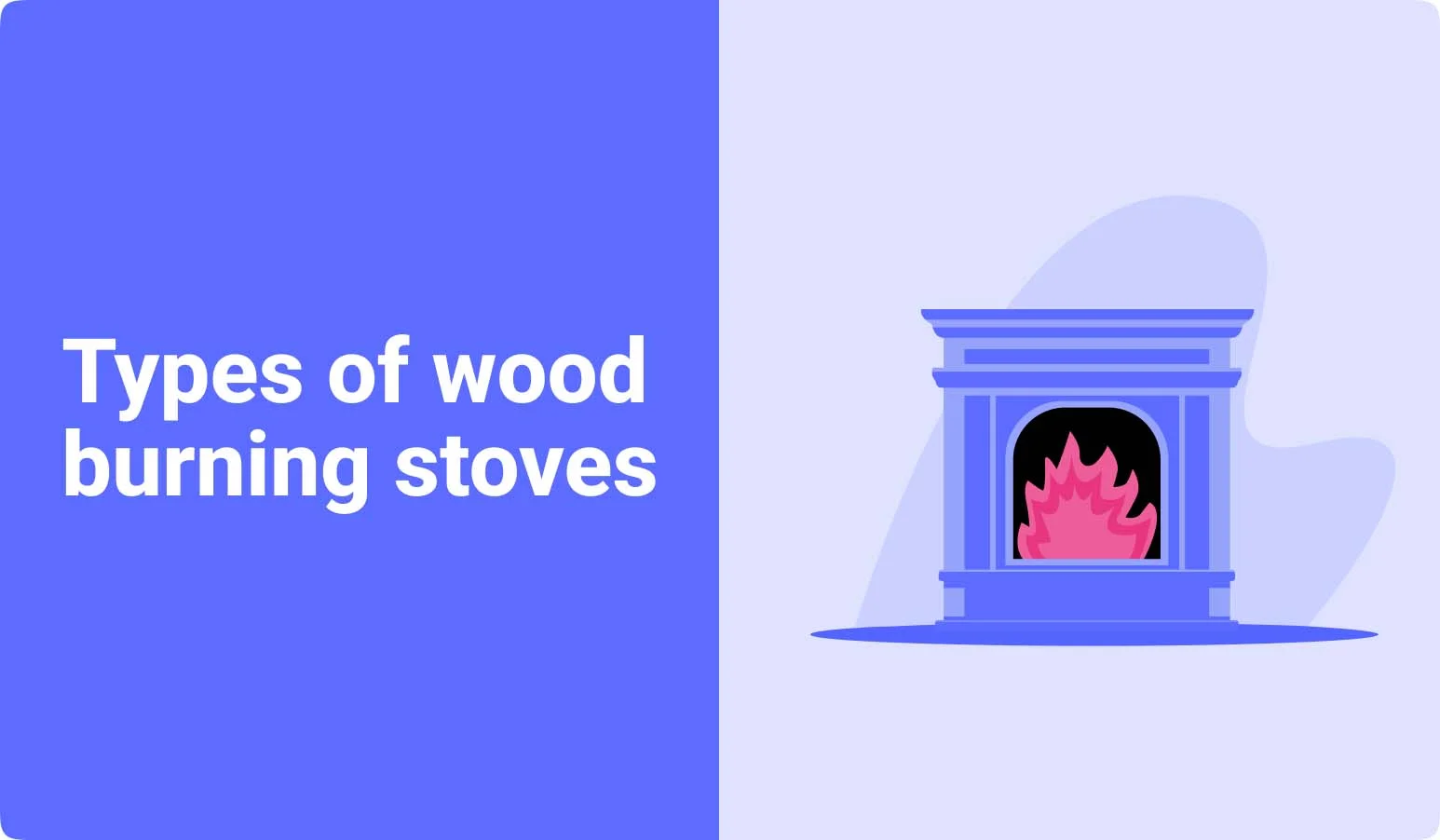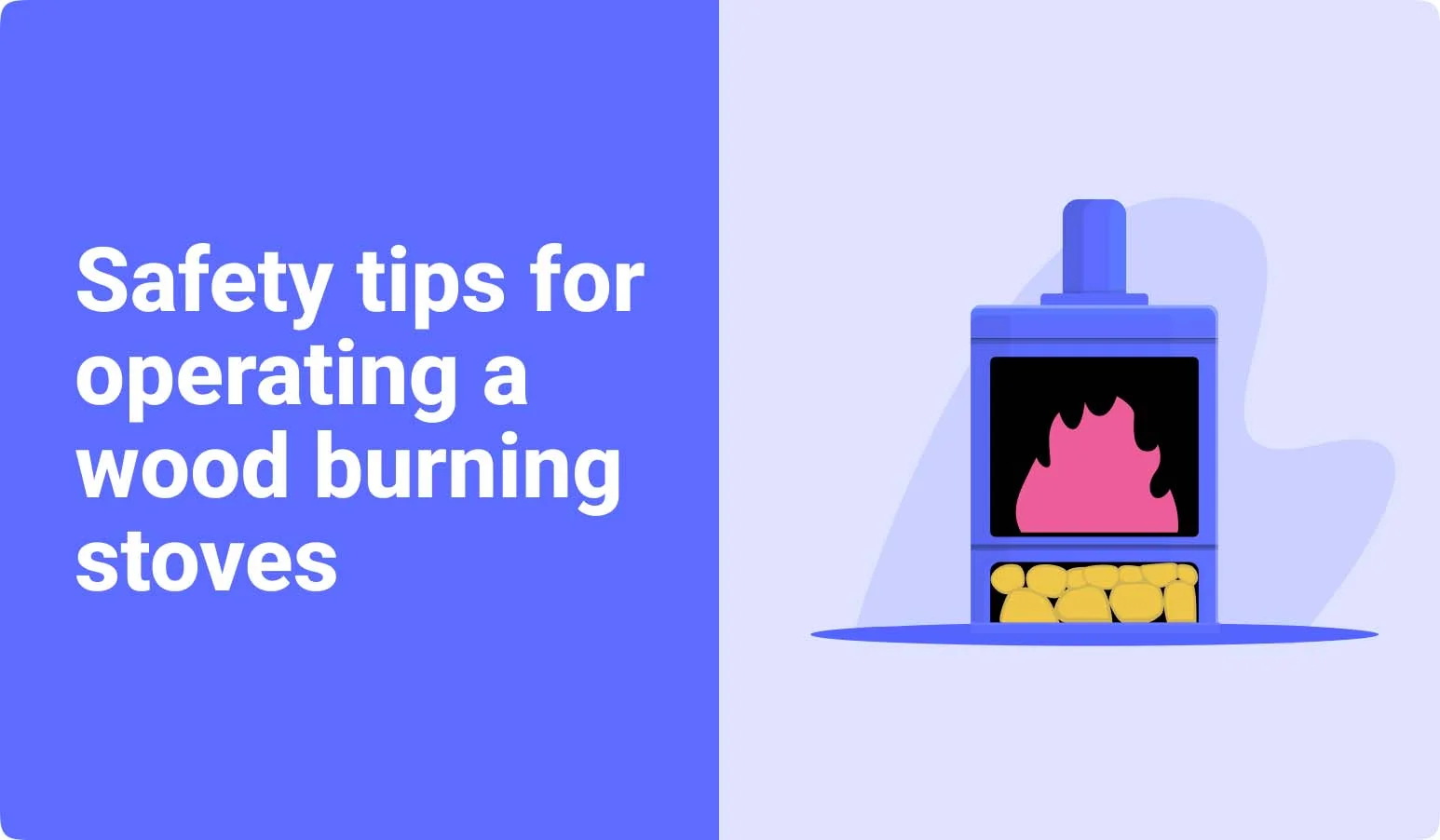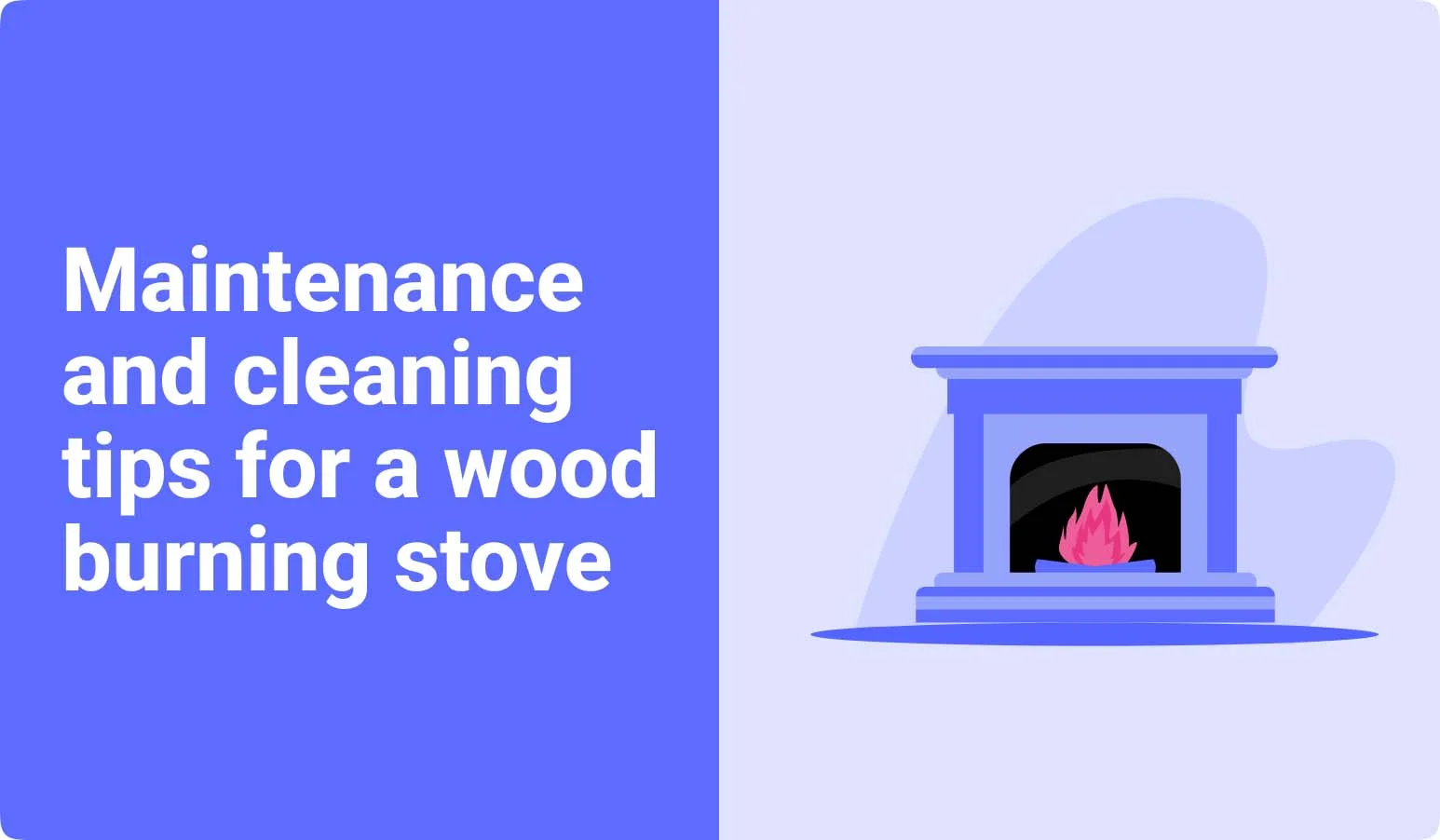UPDATED: AUGUST 10, 2023 | 1 MIN READ

According to the National Fire Protection Association, using a wood burning stove or device is one of the leading causes of home fires. This article discusses the safety measures homeowners should take when using a wood burner and how they can protect their property with wood burner insurance.
Why would my home insurance cost more if I have a wood-burning stove?
The cost of home insurance largely depends on the stove you have in your house. Wood-burning stoves are more expensive than gas ovens, so people with wood-burning stoves typically have to pay higher rates for home insurance.
Wood-burning stoves aren’t as safe as gas ovens, producing more ash and soot. This means that homeowners with wood-burning stoves are at a higher risk of having an accident like a chimney fire or a house fire due to increased creosote buildup in their homes. These risks mean homeowners with wood-burning stoves will typically have to pay higher rates for home insurance.
Wood-burning stove insurance requirements
Wood stoves are a great way to stay warm in the winter. They are a great heat source and can also be used for cooking. However, they aren’t without risk of fire. Wood stoves require insurance coverage to protect against damage from fire and other disasters.
Home insurance company requirements to cover wood stoves vary by state, but some general rules apply. To get a wood stove insured, you need insurance covering fires, property damage, theft, explosions, or accidents.
Adherence to local fire codes
When installing a wood-burning stove, you must adhere to local fire and building codes. This differs from a scenario where we’d recommend a DIY approach – instead, consider hiring a professional to install your stove.
Licensed contractors
A Wood Energy Technology Transfer (WETT certificate) inspection is a thorough inspection of your wood-burning appliance by a WETT-certified professional. Some insurance companies may only insure an older home with a professional doing a review first and providing recommendations to increase fire safety. They may only insure your home with professional installation of the wood-burning appliance.
EPA regulations
The EPA now has strict regulations for wood-burning stoves. Wood stoves must be certified by the EPA and have a label that says “EPA Certified.” The standards govern the manufacture and sale of new residential wood heating devices. Still, they don’t apply to wood stoves and other wood heaters previously installed in peoples’ homes. Therefore, you may be exempt if you’ve had a wood stove for many years.
Statistics related to wood burning stoves
The NFPA reports that between 2014-2018, heating equipment, including wood-burning stoves, accounted for an annual average of 45,200 home fires in the U.S., resulting in an average of 620 civilian deaths, 1,520 civilian injuries, and $1.1 billion in direct property damage.
Creosote buildup in chimneys is a common cause of chimney fires. The NFPA states that between 2014-2018, chimney or chimney connector fires accounted for an annual average of 8,900 home fires in the U.S., resulting in an average of 30 civilian deaths, 80 civilian injuries, and $216 million in direct property damage.
Insurance companies that cover wood stoves
Most large home insurance carriers cover wood stoves. However, they must meet the pre-defined requirements discussed above.
Sometimes, your home insurance company might send an inspector out to ensure the stove meets the requirements. You might also need to send pictures of the stove to the company.
Types of wood burning stoves

Traditional cast iron stoves
- Cast iron stoves have a classic and timeless design, often featuring ornate detailing.
- They are known for their durability and heat retention capabilities.
- Cast iron stoves take longer to heat up but retain heat for longer periods, providing consistent warmth.
- They require regular maintenance, including cast iron seasoning, and may need periodic resealing to prevent air leaks.
- Cast iron stoves can be more expensive than other options but are often considered a long-term investment due to their longevity.
Modern steel stoves
- Steel stoves are lightweight and offer a contemporary design with sleek lines.
- They heat up quickly and distribute heat efficiently, providing warmth in a shorter time.
- Steel stoves are generally more affordable than cast iron stoves.
- They may require frequent maintenance to prevent rust, as steel is more prone to corrosion than cast iron.
- Some steel stoves have advanced features like air wash systems that keep the glass door clean by directing airflow.
Pellet stoves
- Pellet stoves use compressed wood pellets as fuel, offering a convenient and automated heating option.
- They have a hopper that automatically feeds pellets into the stove, allowing for longer burn times.
- Pellet stoves are highly efficient and produce consistent heat output.
- They require electricity to operate the hopper and pellet feed system.
- Pellet stoves have relatively low emissions and are considered an environmentally friendly option.
- Regular maintenance includes cleaning the hopper, ash pan, and exhaust system and checking and replacing gaskets and seals.
Pros and Cons
- Traditional Cast Iron Stoves: Pros: Durable, long-lasting, excellent heat retention, classic design. Cons: Longer heat-up time, higher maintenance requirements, higher initial cost.
- Modern Steel Stoves: Pros: Quick heat-up time, efficient heat distribution, affordable. Cons: More susceptible to rust, may require more maintenance and less heat retention than cast iron.
- Pellet Stoves: Pros: Automated fuel feeding, high efficiency, low emissions, longer burn times. Cons: Requires electricity, regular maintenance of hopper and exhaust system, initial cost, and ongoing cost of wood pellets.
When choosing a wood-burning stove, consider factors such as your heating needs, desired aesthetic, budget, and availability of fuel. It’s also important to check the stove’s efficiency ratings and consult with a reputable dealer or professional for guidance on selecting the most suitable option for your home.
Safety tips for operating a wood burning stove

Starting and maintaining a fire
- Use dry, seasoned firewood that has been split and properly stored for at least six months. Seasoned wood burns more efficiently, produces less smoke, and reduces the risk of creosote buildup in the chimney.
- Place a small amount of kindling in the stove’s firebox, such as newspaper or small sticks.
- Open the damper and ensure the stove’s air controls are fully open.
- Light the kindling and gradually add larger pieces of firewood as the fire grows.
- Avoid overloading the stove with too much wood, leading to inefficient burning and excessive smoke.
Using the damper and controlling airflow
- The damper controls the draft and airflow in the stove. Open the damper fully when starting a fire to allow for maximum air intake.
- Once the fire is established, adjust the damper to regulate the airflow and control the burn rate.
- Closing the damper partially can help retain more heat while opening it fully increases airflow for a more vigorous fire.
- Experiment with different damper settings to find the optimal balance between heat output and fuel efficiency.
Proper handling of firewood
- Season firewood by storing it in a dry, well-ventilated area for at least six months before use. Moisture content should be around 20% or lower for optimal burning.
- Avoid burning wet or green wood, as it produces more smoke, reduces efficiency, and can lead to creosote accumulation in the chimney.
- Store firewood away from the exterior of your home and any structures to minimize the risk of pests and prevent moisture buildup.
Chimney fire and emergency procedures
- In the event of a chimney fire, immediately contact the fire department and evacuate all occupants.
- Close the stove’s air controls and damper to reduce the fire’s oxygen supply and slow the combustion.
- Use a fire extinguisher approved for chimney fires, if available, to extinguish the fire from the inside. Never use water on a chimney fire, as it can cause steam and potentially worsen the situation.
- If you suspect a carbon monoxide leak or any other emergency related to the stove, evacuate the house and seek fresh air immediately. Contact emergency services for assistance.
Reading and following the manufacturer’s instructions specific to your wood-burning stove model is crucial. Regularly inspect and maintain your stove and chimney to ensure their safe and efficient operation. By following these safety tips, you can enjoy the warmth and comfort of your wood-burning stove while minimizing the risks associated with its use.
Maintenance and cleaning tips for a wood burning stove

Regular maintenance and cleaning are essential to ensure your wood-burning stove’s safe and efficient operation. Here are some detailed instructions on how to clean and maintain your stove:
Removing ashes
- Allow the ashes to cool completely before removing them from the stove.
- Use a metal scoop or shovel to carefully scoop the ashes and transfer them to a metal container with a tight-fitting lid.
- Store the container outside, away from combustible materials, until the ashes are completely cooled and safely disposed of.
Cleaning the glass door
By following these maintenance and cleaning tips, you can keep your wood-burning stove in good working condition and minimize the risk of chimney fires or other issues. Remember always to follow the manufacturer’s guidelines and consult with a professional if you have any concerns or questions regarding the maintenance and cleaning of your specific wood-burning stove model.
FAQs
Does your house insurance go up with a wood stove?
Wood-burning stoves can increase home insurance premiums, but the increase is usually small. The increased amount will vary depending on the insurance company and the type of stove. Wood stoves are more likely to cause fires than pellet stoves, so you may see a higher increase if you have a wood stove.
How does home insurance work with a fire?
Homeowners insurance can help pay to repair or replace damaged or destroyed belongings in a fire. Landscaping, such as trees and shrubs, may also be covered under a standard homeowners policy. If a fire on your property destroys a tree or shrub, you may be reimbursed for some or all of its value.
Does having a log burner increase home insurance?
A log burner in your home can potentially increase your home insurance premiums. While log burners provide a cozy and efficient heat source, they also pose additional risks that insurers consider, such as increased fire risk.
Does a wood-burning stove affect insurance?
Homeowners should be cognizant of the necessity to demonstrate that their wood-burning stove conforms to the relevant fire codes and EPA regulations. They may need an inspection by a WETT-certified professional to obtain insurance coverage. To secure insurance for your wood-burning stove, you may be obligated to cover fire, explosions, theft, accidents, and property damage.
Does installing a wood stove increase home insurance?
Installing a wood stove can affect your home insurance rates. Some insurance companies will increase the price of your policy if you install a wood stove because it’s an added risk. Others will not increase the cost of your policy but may charge a higher premium for the coverage.
How does home insurance work with fire?
Having a wood-burning stove does carry a risk of causing a fire. If your wood-burning stove does cause a fire, here are the steps you should follow with your insurance company. File your insurance claim as soon as possible; some policies have a certain number of days you have to file a claim after a fire.
Please note any personal property damage and notify the insurance company. The insurance company will then send out an adjuster to review the damage and report back to the insurers to process the claim.
Does having a gas fireplace increase your insurance?
A fireplace on your property may impact your home insurance policy; the effect on your premiums will depend on the type of fireplace and your insurance provider. A gas-burning fireplace is less risky than a wood-burning stove, so they are generally cheaper to insure.
Is a pellet stove considered a wood-burning stove?
A pellet stove is a different type of wood-burning stove. Unlike a traditional wood-burning stove, it burns pellets made from compressed sawdust or recycled wood waste, which are sometimes mixed with other biomass fuels. It’s important to remember that firewood for a traditional wood-burning stove can be kept outdoors, both covered and uncovered. To remain dry, a bag of wood pellets must be stored in a sheltered area, such as a shed.
What is the difference between a wood-burning stove and a fireplace?
A wood-burning stove is a device that burns wood or other solid fuel to provide heating, typically in a domestic setting. The stove has an insulated chimney that channels the combustion products up and out of the building.
A fireplace is a structure made of brick, stone, or other rigid material and designed to contain firewood, coal, and embers for heating a room. Modern wood-burning stoves must follow EPA regulations and more efficient at heating a room than a fireplace.
How does home insurance work if there is a gas leak?
A standard homeowners insurance policy usually covers explosions caused by a gas leak. However, there are some scenarios where a standard homeowners insurance policy won’t cover a gas leak. Common causes of gas leaks include an appliance that has not been correctly maintained, a slow leak that’s causing damage to other appliances, or incorrect installation.
How do I find out if my home insurance covers a wood-burning stove?
Most insurance companies will cover wood-burning stoves if they meet the minimum safety requirements. When you inform your insurance company of your wood-burning stove, they might request that a WETT-certified inspector conduct an inspection.
What is the cost of home insurance with a wood-burning stove?
Home insurance companies can add up to 10% to your homeowners policy premiums for a wood stove or charge a flat fee annually instead. The exact amount it costs to cover a wood-burning stove can vary depending on the insurance provider and policy.
How to get home insurance with a wood-burning stove
If you’re looking for a home insurance policy, there are a few things that you should keep in mind. Your property value is an essential factor, as well as what type of coverage you need. Consider how much deductible you want to pay upfront and what deductibles will be covered by your insurer.
Wood-burning stoves are a great way to save money on heating bills but can also be a safety hazard. If you’re considering one, select the right homeowners insurance.
Before committing to anything, you should research to get the best home insurance premium deal. Complete our online request form to see your area’s rates and connect with a licensed agent.
Related content:
- Fire Damage and Mitigation: What Every Homeowner Should Know
- What To Do After A Major House Fire
- Most Common Causes of House Fires
- How To Start a Fire In a Fireplace
- 10 Reasons Why Home Insurance Rates Increase